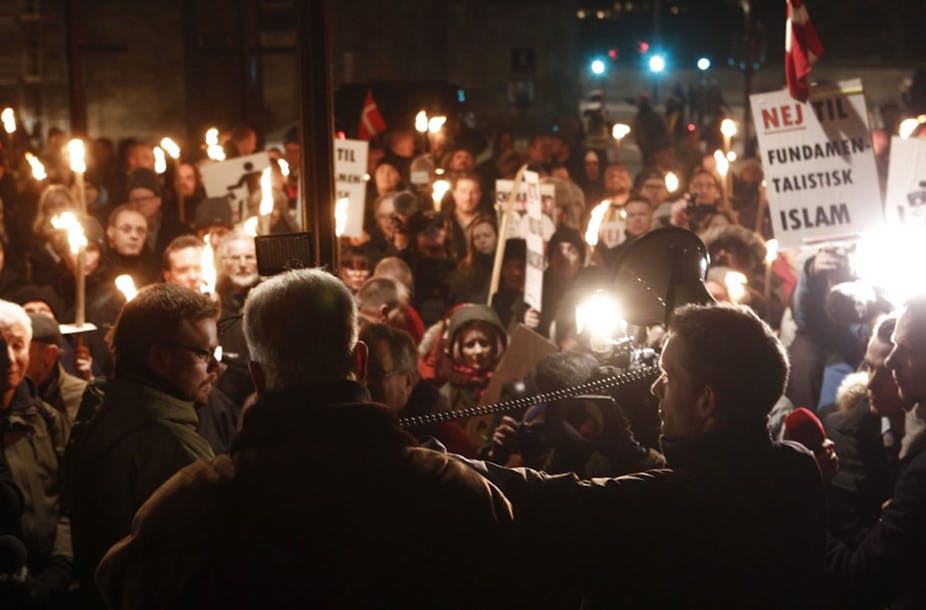There is widespread concern among civil society and policymakers in Europe that the large number of asylum seekers could be driving anti-immigrant attitudes – that the perceived “refugee crisis” could be instilling the fear among the general public that their material wellbeing, culture and even jobs are under threat. This could in turn create a fertile ground for right-wing populists, or so goes the argument.
This line of thinking can be traced back to group conflict theory (GCT), which posits that competition over scarce resources gives rise to perceptions of ethnic threat. Majority-group members are assumed to be responsive to the economic context and immigrant-group size. In unfavourable or deteriorating economic contexts, goods that are the object of intergroup competition become scarcer. This leads to intensified economic competition and sets off threat perceptions. A stronger presence of immigrant groups implies that the majority group faces a larger number of competitors, which reinforces intergroup competition.
But to what extent does the evolution of threat perceptions in contemporary Europe match group conflict theory? To understand this question, a chapter in our book (published on October 24) analyses the evolution of ethnic threat perceptions over the past 20 years across Europe. Diverging national evolutions shed more light on the contextual factors driving feelings of ethnic threat. We distinguish between economic and cultural threat perceptions, as previous research has illustrated that citizens can fear the impact of migration for these reasons.
North versus east divide
To map the evolutions in perceived economic and cultural threats, we use the European Social Survey time series, with eight rounds of data collected between 2002-03 and 2016-17 in 26 countries. In total, these rich and high-quality data include more than 240,000 randomly selected respondents. The graphs below display the country-specific evolutions, grouped by region.


Considerable cross-national differences in threat perceptions are visible. In Northern Europe, the average scores on economic and cultural-threat perceptions are comparatively low and hardly evolved between 2002 and 2016. In the strong welfare economies of Northern Europe, neither the economic crisis nor the “refugee crisis” has led to more widespread concerns among the population about the presence of immigrants.
The situation is significantly different in Eastern Europe, where perceptions of economic as well as cultural threats are much more prevalent. This interesting finding is at odds with conflict-based theories: Eastern Europeans live in societies that host relatively small numbers of immigrants, but nevertheless report the highest levels of perceived ethnic threat. In most European countries and for most of the time series, the economic-threat scores are higher than cultural-threat scores. Eastern Europeans perceive immigrants as a material threat rather than one to the national identity. However, from 2014 onward there is an increase in threat perceptions, more marked for cultural than economic reasons.
Average threat-perception levels in Western European countries are largely situated between the low levels observed in Northern Europe and the high ones in Eastern Europe. Despite the economic crisis and increased inflow of asylum seekers, threat perceptions in most Western European countries show a remarkable degree of stability.
In Southern Europe, mixed patterns can be observed. Countries displayed a surge in economic-threat perceptions in the aftermath of the 2008 economic crisis. In almost all countries these economic anxieties appear to have spilled over to the cultural realm as well. Since 2012, however, patterns are more ambiguous and less consistent.

The role of political discourses and mobilizations
The trends observed tend to contradict the central tenet of GCT, that the inflow of immigrants and economic crisis automatically translate into stronger threat perceptions among the majority population. While the data illustrate that economic-threat perceptions did gain strength between 2008 and 2010, especially in the countries that were hit hard by the economic crisis, this proved to be short-lived, and by 2012 they had fallen back to earlier levels.
Threat perceptions have generally been stable since 2012, with the exception of specific countries. The sharpest increase occurred in Eastern Europe, which experienced only small inflows of asylum seekers, while in European countries that received larger inflows, threat perceptions remained stable. Analysis shows that worse economic contexts and higher numbers of asylum seekers do not lead to preferences for more-restrictive asylum and immigration policies.
Intergroup competition cannot explain this intriguing pattern – sudden inflows of asylum seekers do not necessarily or automatically set of a backlash of threat perceptions among the majority population. Instead, our results suggest that the political climate and media discourses on immigration and asylum might be more relevant, that the frame that political elites and media employ is what matters. Indeed, prior research shows that frames adopted by the media and political parties are important in shaping attitudes toward immigrants.
For example, the negative perceptions in Eastern Europe closely match the policy stance in a majority of these countries. The case of Hungary in particular illustrates how mobilizations against migrants and the presence of extreme-right wing discourses are able to set off an opinion shift among a substantial part of the population. The timing of events is of essence: The election of Viktor Orbán in Hungary and the aggressive governmental campaign against asylum seekers and refugees precedes a sudden increase in cultural-threat perceptions. In this sense, the presence of the extreme-right seems to cause a hostile opinion climate rather than the other way around.
Public opinion should not be seen so much as a driver of the strength of political parties, but rather as the consequence of political conflict. Given that we observe a high degree of stability of threat perceptions in many of the countries, our analysis suggests that recent electoral successes of radical right parties are not attributable to changes in public opinion on the topic of immigration. Put another way, the supply side of politics thus seems a more-important driver in fuelling anti-immigration climates than the demand side.

